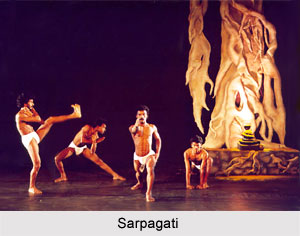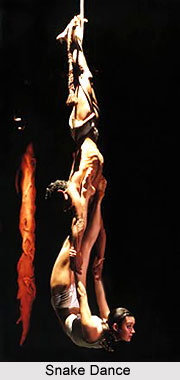 Sarpagati is an influential dance theatre work that has become a landmark in modern Indian dance. This dance form is inspired from the importance of snake worship in Indian culture. Sarpagati draws upon rituals, myth and symbolism associated with the snake. According to the popular belief the snake is often associated with fertility, wealth and power. In Tantric Language, the snake represents the primal creative energy or Kundalini which lies dormant in the base of the spine, which, when aroused, ascends and activates the chakras of the subtle body.
Sarpagati is an influential dance theatre work that has become a landmark in modern Indian dance. This dance form is inspired from the importance of snake worship in Indian culture. Sarpagati draws upon rituals, myth and symbolism associated with the snake. According to the popular belief the snake is often associated with fertility, wealth and power. In Tantric Language, the snake represents the primal creative energy or Kundalini which lies dormant in the base of the spine, which, when aroused, ascends and activates the chakras of the subtle body.
"The Way of the Serpent" mainly refers to the demonstration of this energy within the context of the lower three chakras, denoted as the Earth, Water and Fire. These actually relate to the three fundamental drives that form the basis of survival, the drive to procreate, to accumulate and to dominate.
Sarpagati is represented in five major sections: Kundalini, Earth, Water, Fire and Garuda.
Kundalini
Underneath the massive canopy of Banyan Tree, an elderly woman offer turmeric powder to the Sarpalingam. With the legend of creation, Lord Vishnu, reclines on Ananta, the snake stands for timelessness. The old woman then transforms into Kundalini.

Earth
The element Earth is denoted in tantra by a yellow square of first chakra metaphysically represented special extension- the realm of four direction and two dimensions (length and breath). On an individual level as well, the earth element actually stands for the basic drive for a protected material base for life. The defensive instinct of animals and humans is an expression of drives that are actually associated with the first chakras. This power is also seen in the consumption of creative energy for material gain, which covers a huge spectrum from providing the basic physical requisites of life (food, clothing, shelter), to the accumulation of vast wealth and possessions.
Water
This element, water is very important. It is actually depicted by the white hemispherical structure of the second chakras that stands for both flow and balance. It symbolizes fluid balancing of opposites -dynamic equilibrium. On a more individual scenario it includes sensuality and the push of organism to perpetuate through procreation. As per metaphysical level it represents act of creation itself, in which the universe is created because of meeting of two opposite forces. A powerful symbol of union of opposite is called the Sarpalingam, in which the snake, representing active female energy, coils around and activates the dormant male principle, represented by the lingam.
Fire
Another crucial element -fire- is associated with the third chakras, and is often represented by the red triangle. This fire represented both power and intensity. The passion to excel, and drive to conquer are both crucial expression of transformation of creative energy in the third chakras. Fire as a symbol also stands for death and burning ghat, a psychic trap-door between this world and next, between the material and the spiritual world.
Garuda
The serpent is transformed into the golden bird, from the death of lower self. And with the initiation of compassion, the path of higher chakras commences.



















